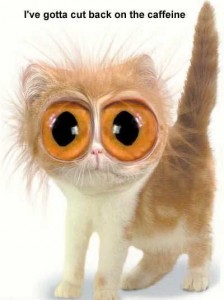 Time was, a person looking for a caffeine buzz headed for a cup of coffee or can of soda. These days, all kinds of things are being caffeinated. There are drinks such as Monster Energy Drink, concentrated drinks, such as 5 hour Energy Shot, and even inhalable caffeinated products, such as AeroShot. Frito Lay, the makers of that carmelized popcorn with the toy inside, Cracker Jacks, recently released a new line of caffeinated snacks, called Cracker Jack’d. A popular product in this line is Perky Jerky, a caffeinated beef jerky.
Time was, a person looking for a caffeine buzz headed for a cup of coffee or can of soda. These days, all kinds of things are being caffeinated. There are drinks such as Monster Energy Drink, concentrated drinks, such as 5 hour Energy Shot, and even inhalable caffeinated products, such as AeroShot. Frito Lay, the makers of that carmelized popcorn with the toy inside, Cracker Jacks, recently released a new line of caffeinated snacks, called Cracker Jack’d. A popular product in this line is Perky Jerky, a caffeinated beef jerky.
Is there really a need for these products by our body? The answer is no. Caffeine is a stimulant drug with an addictive quality that can vary greatly among people based upon genetic differences. In addition to being a stimulant, caffeine blocks a chemical that helps calm the brain. When this chemical is blocked, stress hormones increase. Increased stress hormones can increase insulin resistance and fat storage, suggesting a link to obesity and diabetes. Caffeine also increases water loss from the body, increasing risk for dehydration. Sleep deprivation is also linked to caffeine use – aren’t we all always looking for more sleep?
These caffeinated products create the need for more caffeine, ensuring a quite profitable demand curve for manufacturers. Unfortunately, this “need” for a buzz is being created in younger and younger children. According to the Journal of Pediatrics, at least 75% of children surveyed consumed caffeine on a daily basis. Researchers at the University of Buffalo have been studying the effects of caffeine on adolescents and their studies have shown that teens, particularly teenage boys, can quickly become “addicted” to caffeine even after being exposed to it for a short period of time. They have found that it was not the marketing or taste of caffeinated products that drew teenagers in but the caffeine itself. Once exposed to caffeine, researchers found that teens were sometimes so motivated to get more that they resorted to behaviors including lying and stealing.
The Food and Drug Administration does not require the caffeine content to be stated on the package, raising concern about the total amount of caffeine being consumed daily, particularly with the new surge in caffeine-containing food products. Consumers, particularly children, are often unaware of how much caffeine they are ingesting. Consider the caffeine (in mg) in these few products:
22 oz NOS High Performance Energy Drink: 357 mg
16 oz Monster Energy Drink: 160 mg
9.5 oz Starbucks Frappuccino: 115 mg
6 oz coffee: 80 mg
8.4 oz Amp energy drink: 74 mg
12 oz Mountain Dew: 54 mg
16 oz Snapple (peach): 42 mg
12 oz Coca-Cola: 35
8 oz hot cocoa: 9 mg
Talk to your kids about caffeine. Teach them that it is a drug with an addictive effect. If nothing else, talk to your teens about the dangers of drinking caffeinated alcoholic drinks, products which have resulted in numerous hospitalizations. And, while talking about all this, try not to do so while snuggling with your own cup of Starbucks.
